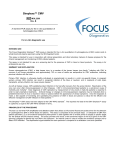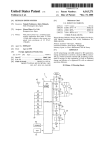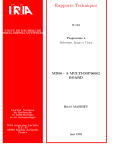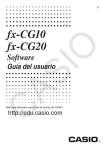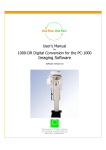Download Portable x-ray device
Transcript
US007496178B2 (12) United States Patent (10) Patent N0.2 Turner (54) US 7,496,178 B2 (45) Date of Patent: PORTABLE X-RAY DEVICE (56) *Feb. 24, 2009 References Cited U.S. PATENT DOCUMENTS (75) Inventor: D. Clark Turner, Payson, UT (US) 3,728,457 A 4/1973 Lundin Continued (73) Assignee: AribeX, Inc., Orem, UT (U S) ( ) FOREIGN PATENT DOCUMENTS ( * ) Notice: Subject‘ to any disclaimer, the term ofthis EP 0247758 12/1987 patent is extended or adjusted under 35 U.S.C. 154(b) by 395 days. (Continued) Tlhis patent is subject to a terminal dis- OTHER PUBLICATIONS c a1mer. Fiorini, C.; Longoni, A.; MilaZZo, M.; Zaraga, F, In-situ, non-de ( 21 ) APP 1_ NO; 10/529 , 805 (22) PCT Filed, Feb 18 2005 ' (86) PCT No.: § 371 (0X1), (2)’ (4) Date; ' structive identi?cation of chemical elements by means ofportable EDXRF spectrometer. Nuclear Science Symposium, 1998. Confer ence Record. 1998 IEEE, v01. 1, Iss., 1998, pp. 375-380, v01. 1 ’ (Abstract). PCT/US2005/005712 (Continued) Primary Examinerilrakli KiknadZe (74) Attorney, Agent, or FirmiKenneth E. Horton; Kirton Aug 1, 2005 and McConkie (87) PCT Pub. No.: WO2005/081956 (57) ABSTRACT PCT Pub. Date: Sep. 9, 2005 _ (65) _ _ Portable X-ray devices and methods forusing such devices are Pnor Pubhcatlon Data Us 2007/0269010 A1 NOV 22 2007 ' . (60) (51) ’ loW-density insulating material containing a high-Z sub . stance. The devices can also have an integrated display com Related U's' Apphcatlon Data Provisional application No. 60/546,575, ?led on Feb. 20, 2004' Int_ CL H05G 1/10 (52) (58) described. The devices have an X-ray tube poWered by an integrated poWer system. The X-ray tube is shielded With a ponent. With these components, the siZe and Weight of the X-ray devices can be reduced, and the portability of the devices enhanced. Thus, the portable X-ray devices are espe cially useful for applications Where portability is an important feature such as in ?eld Work, remote operations, and mobile (2006 01) operations such nursing homes, home healthcare, teaching ' US. Cl. ..................................... .. 378/ 101; 378/ 102 Field of Classi?cation Search ................. .. 378/98, classrooms. This portability feature can be particularly useful in multi_suite medical and dental o?ices Where a Single X_ray device can be used in multiple of?ces instead of single using 378/98.2, 98.8, 101*104, 109*112, 119, an X-ray device in each of?ce. 378/ 1 91 See application ?le for complete search history. 24 Claims, 9 Drawing Sheets US 7,496,178 B2 Page 2 3,828,194 3,925,672 4,039,811 4,191,889 4,221,969 4,311,913 4,490,834 4,646,338 4,694,480 4,768,216 4,775,992 4,797,907 4,809,311 4,811,375 4,856,036 4,930,146 4,979,198 5,077,771 5,111,493 5,153,900 5,379,335 US. PATENT DOCUMENTS Kastis, G.A.; Furenlid, L.R.; Wilson, D.W.; Peterson, T.E.; Barber, H.B.; Barrett, H.H., Compact CT/SPECTsmall-animal imaging sys A A A A A A A A A A A A A A A A A A A A A tem, Nuclear Science, IEEE Transactions on, vol. 51, Iss. 1, Feb. 2004 pp. 63-67 (Abstract). 8/1974 12/1975 8/1977 3/1980 9/1980 1/1982 12/1984 2/1987 9/1987 8/1988 10/1988 1/1989 2/1989 3/1989 8/1989 5/1990 12/1990 12/1991 5/1992 10/1992 1/1995 Grasser Soder et al. Ennslin et al. Cowell Schmidt Resnick et al. Sudani Skillicorn Skillicorn Harvey et al. Resnick et al. Anderton Arai et al. Klostermann Malcolm et al. Flakas et al. Malcolm et al. Skillicorn Siedband Nomikos et al. Griesmer et a1. 5,442,677 A * 8/1995 Golden et al. ............. .. 378/102 5,631,943 5,708,694 6,038,287 6,205,200 5/1997 1/1998 3/2000 3/2001 Miles Beyerlein et a1. Miles Boyer et al. 8/2001 GrodZins ................... .. 378/87 A A A B1 6,282,260 B1 * 6,327,338 B1 6,459,767 B1 12/2001 Golovanivsky 10/2002 Boyer 6,661,876 B2 12/2003 Turner et al. 6,822,250 B2 * 11/2004 Korenev ................ .. 250/492.3 2003/0002627 A1 l/2003 Espinosa et al. 2003/0048877 A1 2003/0142788 A1 3/2003 Price et al. 7/2003 Cho et al. 2005/0018817 A1 2005/0053199 A1 2005/0213709 A1 1/2005 Oettinger et al. 3/2005 Miles 9/2005 Dinsmore et al. FOREIGN PATENT DOCUMENTS EP EP EP JP JP JP JP W0 W0 W0 W0 W0 0488991 0524064 0784965 59-073897 62-246300 62-283600 03-225797 W0 92-04727 WO 95/20241 W0 96-05600 WO 2004047504 WO 2005008195 6/1992 1/1993 7/1997 4/1984 10/1987 12/1987 10/1991 3/1992 7/1995 2/1996 6/2004 1/2005 Shrivastave, P.; O’Connell, S.; Whitley, A., Handheld x-ray?uores cence.‘ practical application as a screening tool to detect the presence of environmentally-sensitive substances in electronic equipment, Electronics and the Environment, 2005. Proceedings of the 2005 IEEE International Symposium on, vol., Iss., May 16-19, 2005 pp. 157-162 (Abstract). Idrissi, M.M.; Dudemaine, M., Viladrosa, R.; Robert, E.; Cachoncinlle, C.; Pouvesle, J .M., Experimental study and develop ment of a single focus burst X-ray ?ash, Pulsed Power Conference, 2003. Digest of Technical Papers. PPC-2003. 14th IEEE Interna tional, vol. 2, Iss., Jun. 15-18, 2003 pp. 752-755 vol. 2 (Abstract). Maur, F., X-ray inspection for electronic packaging latest develop ments, Electronic Packaging Technology Proceedings, 2003. ICEPT 2003. Fifth International Conference on, vol., Iss., Oct. 28-30, 2003 pp. 235-239 (Abstract). Matsumoto, T.; Mimura, H., X-ray radiography system using graph ite-nano?bers cold cathode, Vacuum Microelectronics Conference, 2003. Technical Digest ofthe 16th International, vol., Iss., Jul. 7-11, 2003 pp. 301-302 (Abstract). Kastis, G.A.; Furenlid, L.R.; Wilson, D.W.; Peterson, T.E.; Barber, H.B.; Barrett, H.H., Compact CT/SPECTsmall-animal imaging sys tem Nuclear Science Symposium Conference Record, 2002 IEEE, vol. 2, Iss., Nov. 10-16, 2002 pp. 797-801 vol. 2 (Abstract). Bertolucci, E.; Boerkamp, T.; Maiorino, M., Mettivier, G.; Montesi, M.C.; Russo, P., Portable system for imaging of/spl alpha/, /spl beta/ and X-ray sources with silicon pixel detectors and Medipix 1 read out, Nuclear Science Symposium Conference Record, 2001 IEEE, vol. 2, Iss., Nov. 4-10, 2001 pp. 709-713 vol. 2 (Abstract). Longoni, A.; Fiorini, C.; GuaZZoni, C.; Gianoncelli, A.; Struder, L.; Soltau, H.; Lechner, P.; Bjeoumikhov, A.; SchmalZ, J .; Langhoff, N.; Wedell, R.; Kolarik, V., A new HP spectrometer based on a ring shaped multi-element Silicon Drift Detector and on X-ray capillary optics, Nuclear Science Symposium Conference Record, 2001 IEEE, vol. 2, Iss., Nov. 4-10, 2001, pp. 897-901 vol. 2 (Abstract). Shirochin, L.A.; Fursey, G.N., High-power soft X-ray tube with an explosive emission cathode, Discharges and Electrical Insulation in Vacuum, 1998. Proceedings ISDEIV. XVIIIth International Sympo sium on, vol. 2, Iss., Aug. 17-21, 1998, pp. 672-674 vol. 2 (Abstract). Fursey, G.N., Shirochin, L.A., Explosive emission phenomenon and portable X-ray tubes, Vacuum Microelectronics Conference, 1998, Eleventh International, vol., Iss., Jul. 19-24, 1998, pp. 142-143 (Abstract). Takano, H.; Hatakeyama, T.; Sun, J.M., Laknath, K.G.D.; Nakaoka, M., Feasible characteristic evaluations of resonant PWM inverter linked DC-DC power converter using high-voltage transformer parasitic circuit components, Power Electronics and Variable Speed Drives, 1996. Sixth International Conference on (Conf. Publ. No. OTHER PUBLICATIONS Mesyats, G.A.; Shpak, V.G.; Yalandin, M.I.; Shunailov, S.A. RADAN-EXPER T portable high-current accelerator, Pulsed Power Conference, 1995. Digest of Technical Papers. Tenth IEEE Interna tional, vol. 1, Iss., Jul. 3-6, 1995, pp. 539-543 vol. 1 (Abstract). Fiorini, C.; Longoni, A. In-situ, non-destructive identi?cation of chemical elements by means of portable EDXRF spectrometer, Nuclear Science, IEEE Transactions on, vol. 46, Iss. 6, Dec. 1999 pp. 429), vol., Iss., Sep. 23-25, 1996 pp. 525-533. ShirouZu, S.; Inoue, S., A new type X-ray instant camera, Nuclear Science, IEEE Transactions on, vol. 39, Iss.5, Oct. 1992 pp. 1528 1531 (Abstract). Sudarkin, A.N.; Ivanov, O.P.; Stepanov, V.E.;Volkovich, A.G.; Turin, A.S.; Danilovich, A.S.; Rybakov, D.D.; Urutskoev, L.I., High-energy radiation visualizer (HERV): a new system for imaging in X-ray and gamma-ray emission regions, Nuclear Science, IEEE Transactions 2011-2016 (Abstract). on, vol. 43, Iss.4, Aug. 1996, pp. 2427-2433 (Abstract). Bertolucci, E.; Boerkamp, T.; Maiorino, M., Mettivier, G.; Montesi, M.C.; Russo, P. Portable system for imaging of/spl alpha/, and X-ray Longoni, A.; Fiorini, C.; GuaZZoni, C.; Gianoncelli, A.; Struder, L.; Soltau, H.; Lechner, P.; Bjeoumikhov, A.; SchmalZ, J .; Langhoff, N.; sources with silicon pixel detectors and Medipix] readout, Nuclear Science, IEEE Transactions on, vol. 49, Iss. 4, Aug. 2002 pp. 1845 Wedell, R., A new XRF spectrometer based on a ring-shaped multi 1850 (Abstract). Mesyats, G.A.; Korovin, S.D.; Rostov, V.V.; Shpak, V.G.; Yalandin, MI, The RADAN series of compact pulsed power Generators and their applications, Proceedings ofthe IEEE, vol. 92, Iss. 7, Jul. 2004 pp. 1166-1179 (Abstract). element silicon drift detector and on X-ray capillary optics, Nuclear Science, IEEE Transactions on, vol. 49, Iss.3, Jun. 2002, pp. 1001 1005 (Abstract). Sinha, N.;Yeow, J .T.-W., Carbon nanotubes for biomedical applica tions, NanoBioscience, IEEE Transactions on, vol. 4, Iss.2, Jun. 2005, pp. 180-195 (Abstract). US 7,496,178 B2 Page 3 145 (Abstract). Fry et al., Recent developments in electronic radiography at Los Alamos, Proc. SPIE vol. 3769, p. 111-123, Penetrating Radiation Systems and Applications, Oct. 1999. (Abstract). Smith, et al., Evaluation of a CMOS image detectorfor low-cost and power medical x-ray imaging applications, Proc. SPIE vol. 3659, p. Chuvatin, AS.; Rudakov, L.I.; Velikovich, AL.; Davis, J.; Oreshkin, 952-961, Medical Imaging 1999, May 1999. (Abstract). Kidd, R.; RabinowitZ, P.; Garrison, L.; Meyer, A; Adamson, A; AurouX, C.; Baldauf, J .; Clement, B.; Palmer, A; Taylor, E.; Graham, A, The Ocean Drilling Program III.‘ The shipboard laboratories on “JOIDESResolution ”, OCEANS, vol. 17, Iss., Nov. 1985, pp. 133 V.I. , Heating ofon-axis plasma heatingfor keVX-rayproduction with Z-pinches, Plasma Science, IEEE Transactions on, vol. 33, Iss.2, Apr. 2005, pp. 739-751 (Abstract). Borisov et al., Ultrabright Multikilovolt Coherent Tunable X-Ray Source at ~ 2. 71*293 Afor Biological Microimaging, 2004, Ameri can Institute of Physics 0-7354-0195-0. (Abstract). Momose et al., X-Ray TalbotInterferometryfor Medical PhaseImag ing, 2004 American Institute of Physics 0-73 54-0195-0 (Abstract). Sasaki et al., Protein Crystallography Beam Line at MIRRORCLE, 2004 American Institute of Physics 0-7354-0195-0. (Abstract). Spartiotis et al., Novel direct digital modular x-ray device and system, Proc. SPIE vol. 3336, p. 529-536, Medical Imaging 1998, Jul. 1998. (Abstract). Boyer et al., Pulsed hard x-ray sourcefor nondestructive testing and medical imaging, Proc. SPIE vol. 3154, p. 16-26, Coherent Electron Beam X-Ray Sources: Techniques and Applications, Oct. 1997. (Abstract). Xiang et al., New type ofx-ray-Wafer image intensi?er with CsI-CsI/ MCP photocathodes.‘ its design and assessment, Proc. SPIE vol. 1982, p. 230-235, Photoelectronic Detection and Imaging: Technol Hirai, Novel Edge-Enhanced X-Ray Imaging Utilizing Mirrorcle, ogy and Applications ’93, Apr. 1993. (Abstract). Kutlubay et al., Cost-e?ective, high-resolution, portable digital x-ray 2004 American Institute of Physics 0-7354-0195-0. (Abstract). imager, Proc. SPIE vol. 2432, p. 554-562, Medical Imaging 1995, HironariYamada, Features ofthe portable synchrotrons named MIR May 1995. (Abstract). RORCLE, 2004 American Institute of Physics 0-7354-0195-0. Seely et al., Dual-Energy Bone Densitometry Using a Single 100 NS X-Ray Pulse Medical Physics, vol. 25, Oct. 1998 (Abstract). Pi orek, Stanislaw, Field-Porta ble X-Ray Fluorescence Spectrometry.‘ Past, Present, and Future, MetoreX, Inc., Princeton, New Jersey, Mar. 1997. (Abstract). (Abstract). Hironari Yamada, The Synchrotron Light Life Science Center Granted by the MEXT 21 St Century COE Program, 2004 American Institute of Physics 0-7354-0195-0. (Abstract). Hirai et al., Novel Edge-Enhanced X-ray Imaging by MIRRORCLE, “DentalEZ Portable HDX Intraoral X-ray,” User’s Manual, Flow Yue et al., Generation of continuous and pulsed diagnostic imaging X-ray Inc., Mar. 2000 (Abstract). Stumbo et al., Direct Analysis of Molybdenum Target Generated X-ray Spectra with a Portable Device, Medical Physics, Oct. 2004, x-ray radiation using a carbon-nanotube-based?eld-emission cath vol. 31 Issue 10, pp. 2763-2770. 2004 American Institute of Physics 0-7354-0195-0. ode, Applied Physics Letters, vol. 81, No. 2, Jul. 8, 2002. (Abstract). Wang et al., Fast Reconstruction for Uncontained Cone-Beam Moreno et al., Small-Chamber 4. 7 la] Plasma Focusfor Applications, 2001 American Institute of Physics 1-56396-999-8/01 (Abstract). Boyer et al., Portable hard x-ray source for nondestructive testing and medical imaging, Review of Scienti?c Instruments vol. 69, No. 6, Jun. 1998. (Abstract). Mikerov et al., Prospects offast neutron radiography based on por table neutron generators, Proc. SPIE vol. 4142, p. 74-80, Penetrating Tomosynthesis, Proceedings of SPIE, May 2004, vol. 5368, pp. 930 938 (Abstract). Alexander Sasov, Desktop X-Ray Micro-CT Instruments, Proceed ings of SPIE, Jan. 2002, vol. 4053, pp. 282-290 (Abstract). Schewe et al., A Room-Based Diagnostic Imaging System for Mea surement ofPatientSetup, Medical Physics, Dec. 1998, vol. 25, Issue Radiation Systems and Applications II, Dec. 2000. (Abstract). * cited by examiner 12, pp. 2385-2387. US. Patent Feb. 24, 2009 Sheet 1 of9 FIGURE 1 US 7,496,178 B2 US. Patent Feb. 24, 2009 Sheet 2 of9 US 7,496,178 B2 10 FIGURE 2 US. Patent Feb. 24, 2009 Sheet 3 of9 FIGURE 3 US 7,496,178 B2 US. Patent Feb. 24, 2009 Sheet 4 of9 FIGURE 4 US 7,496,178 B2 US. Patent Feb. 24, 2009 Sheet 5 of9 FIGURE 5 US 7,496,178 B2 US. Patent Feb. 24, 2009 Sheet 6 of9 FIGURE 6 US 7,496,178 B2 US. Patent Feb. 24, 2009 Sheet 7 of9 43a FIGURE 7 US 7,496,178 B2 US. Patent Feb. 24, 2009 Sheet 8 of9 FIGURE 8 US 7,496,178 B2 US. Patent Feb. 24, 2009 Sheet 9 of9 FIGURE 9 (PRIOR ART) US 7,496,178 B2 US 7,496,178 B2 1 2 PORTABLE X-RAY DEVICE increases the siZe of the device and the number of system components, and consequently decreases the portability of the device. CROSS-REFERENCE TO RELATED APPLICATION SUMMARY OF THE INVENTION This application claims priority of US. Patent Application The invention relates to portable x-ray devices and meth ods for using such devices. The devices have an x-ray tube Ser. No. 60/546,575, ?led on Feb. 20, 2004, the entire disclo sure of Which is incorporated herein by reference. poWered by an integrated poWer system. The x-ray tube is shielded With a loW-density insulating material containing a FIELD OF THE INVENTION high-Z substance. The devices can also have an integrated The invention generally relates to x-ray devices and meth ods for using the same. More particularly, the invention relates to x-ray tubes used in x-rays devices. Even more display component. With these components, the siZe and Weight of the x-ray devices can be reduced, and the portability of the devices enhanced. Thus, the portable x-ray devices are especially useful for applications Where portability is an important feature such as in ?eld Work, remote operations, particularly, the invention relates to portable x-ray devices that contain an integrated poWer system, methods for using teaching classrooms. This portability feature can be particu such portable x-ray devices, and systems containing such portable x-ray devices. and mobile operations such nursing homes, home healthcare, 20 larly useful in multi-suite medical and dental of?ces Where a single x-ray device can be used in multiple of?ces instead of single using an x-ray device in each of?ce. BACKGROUND OF THE INVENTION BRIEF DESCRIPTION OF THE DRAWINGS Typical x-ray tubes and x-ray devices (device containing x-ray tubes) have been knoWn and used for some time. Unfor 25 tunately, they are usually bulky and are poWered by heavy, high-voltage poWer supplies that restrict mobility. As Well, they are often dif?cult and time-consuming to use. In many instances, a sample for analysis must be sent to an off-site The folloWing description of the invention can be under stood in light of the Figures, in Which: FIGS. 1-2 depict the x-ray device in one aspect of the invention; FIG. 3 depicts the x-ray device in another aspect of the 30 laboratory for analysis by the x-ray device. invention; These limitations can be very inconvenient for many popu lar uses of x-ray devices containing them. Such uses include invention; FIG. 4 depicts the x-ray device in another aspect of the x-ray ?uorescence @(RF) of soil, Water, metals, ores, Well bores, etc., as Well as diffraction and plating thickness mea 35 surements. Typical x-ray imaging applications require the sample to be imaged to be brought to the x-ray device. These limitations have led to an increased interest in making x-ray devices portable. See, for example, US. Pat. Nos. 6,661,876, 6,459,767, 6,038,287, and 6,205,200; US. Published Patent 40 con?guration. FIGS. 1-9 illustrate speci?c aspects of the invention and are a part of the speci?cation. In the Figures, the thickness and 45 ence. Many of these existing designs increase the portability of the same component. Together With the folloWing descrip tion, the Figures demonstrate and explain the principles of the invention. 50 DETAILED DESCRIPTION OF THE INVENTION the portable designs, especially the XRF systems, have inter nal or “integrated” poWer supplies, they don’t have the high The folloWing description provides speci?c details in order x-ray tube current load that is often necessary for x-ray imag ing. For example, energy-dispersive XRF typically requires 55 x-ray beam currents of less than 1 milliampere While x-ray imaging typically requires greater than about 2 milliamperes. Third, high-quality imaging displays for displaying the results of the x-ray analysis are not present. Finally, the radia tion shielding for the x-ray tubes usually comprises lead, Which is quite heavy and limits the portability of the device. the image display component external to the chassis or hous ing containing the x-ray tube. Such a con?guration, hoWever, to provide a thorough understanding of the invention. The skilled artisan, hoWever, Would understand that the invention can be practiced Without employing these speci?c details. Indeed, the invention can be practiced by modifying the illus trated method and resulting product and can be used in con junction With apparatus and techniques conventionally used 60 in the industry. While the invention is described for use in x-ray imaging for dental purposes, it could be used in other medical applications such as medical imaging, veterinary, A further limitation on design of the increased portability is the image collection and display components. Many of the portable designs have the image collection component and con?guration of components may be exaggerated for clarity. The same reference numerals in different draWings represent x-ray devices. At the same time, hoWever, these designs are limited for several reasons. First, most of the designs are not truly portable since they have an external poWer source (i.e., require utility-supplied line voltage). Second, While some of aspect of the invention; and FIG. 9 depicts a conventional x-ray tube in a conventional Applications 2003/0048877, 2003/0002627, and 2003/ 0142788; and European Patent Nos. EP0946082, EP0524064, EP0247758, EP0784965, and EP0488991; the entire disclosures of Which are incorporated herein by refer FIG. 5 depicts the x-ray tube and poWer supply of the x-ray device in one aspect of the invention; FIGS. 6-7 depict the poWer source of the x-ray device and method for connecting the poWer source to the x-ray device in one aspect of the invention; FIG. 8 depicts the x-ray tube of the x-ray device in one and bone densitometry. As Well, it could be used for non dental and non-medical applications such as industrial imag 65 ing, metal fatigue inspections, Weld-inspection for cracks/ voids and pipes, for security inspections alloWing random inspection of parcels and carry-on baggage, and the like. US 7,496,178 B2 3 4 As described above, the invention includes a portable x-ray device that is used primarily for remote and/or applications, including in multi-suite locations. The x-ray device can be designed to be either handheld or temporarily ?xed to a given location, such as a tripod-mount operation. As Well, the inven tion could be mounted on any other semi-stable apparatus, version means converts the initial voltage supplied by the poWer source 40 to a converted voltage that is provided to the poWer supply 34. The conversion means generally converts the 14.4V (or similar voltage) provided by the poWer source 5 40 to a voltage ranging from about 80 to about 200V. In one such as an articulating arm or C-arm as commonly used in aspect of the invention, the initial voltage is converted to a converted voltage of about 100V. Any conversion means radiology applications and described in the publications men knoWn in the art that operates in this manner can be used in the tioned above. The x-ray device is portable in that it can be transported by hand carrying it from one location to a second invention, including the poWer management boards 36. 10 location Without support by any mechanical apparatus. Most importantly, because of its integrated poWer system, the loca The conversion means is electrically connected to the poWer supply 34. The poWer supply 34 steps up the converted voltage (i.e., the 100V) provided by the conversion means to tion of use can be independent of any external ?xed poWer a voltage that can be used by the x-ray tube 30. The poWer source, such as utility-supplied AC voltage commonly avail produced by the poWer supply 34 and input into the x-ray tube able in the home or o?ice. This independence from external poWer source is a de?ning feature of the portable x-ray device described above. As shoWn in FIGS. 1-2, the x-ray device 10 of the invention contains a housing or chassis 20 to contain all the internal components of the device. The housing 20 encloses an x-ray tube 30 for producing the x-rays. The x-ray device 10 contains a poWer system (including poWer source 40) to provide poWer for the device 10 and means for sensing the x-rays, such as 30 via connection 35 (shoWn in FIG. 8) depends on the poWer needed to operate the x-ray tube, and the maximum poWer available from the poWer source. Generally, the poWer pro vided by the poWer supply 34 to the x-ray tube 30 can range from about 20 to about 150 kV. Typically, this poWer provided by the poWer supply can range from about 40 kV to about 100 kV. In one aspect of the invention, the poWer provided by the 20 ?lm, CCD sensors, or imaging plates (not shoWn). The x-ray device 10 also contains means for displaying the results of the 25 analysis such as an integrated image display screen 60 (shoWn in FIG. 4); control means such as controller 70; and radiation shielding 80 to shield the operator of the device from back scattered radiation from the sample. The x-ray device 10 also contains any other components knoWn in the art for ef?cient from the poWer source, and the number of electron-acceler ating grids in the x-ray tube. In one aspect of the invention, the 30 operation (such as x-ray collimator 32), including those com ponents described in the documents mentioned above. The x-ray device 10 contains a unique system for providing poWer to the x-ray device. The poWer system of the x-ray device comprises a poWer source 40, poWer supply 34, and depends on the number of individual poWer supplies used, the 35 40 battery pack. The poWer source can be recharged by any suitable means, such as by connection to an appropriate volt age When using batteries that are re-chargeable. cal connection means can be any of those knoWn in the art. As depicted in FIG. 6, the electrical connection means can com prise an extension member 41 With an electrical connector 42 contained in an upper portion thereof. The mechanical con nection means comprises a release mechanism 43a. 45 range from about 20 kV to about 50 kV. In one aspect of the invention, the poWer provided by each individual poWer sup ply (When there are 2) is about +35 kV and —35 kV. In this embodiment, the +35 kV is attached to the anode of the x-ray tube and the —35 kV is attached to the cathode of the x-ray tube. A ?lament transformer is included in the cathode poWer supply to provide current to the x-ray tube ?lament and gen erate an electron beam at the cathode of the tube. The total poWer produced by the poWer supply is the therefore sum of the individual anode poWer supply and the individual cathode 50 poWer supply. When such individual loW voltage poWer supplies are used, the x-ray tube 30 of the invention becomes more portable. As shoWn in FIG. 7, the x-ray device 10 contains a locking mechanism 43b. To connect the poWer source 40 to the x-ray heat-dissipating capability of the x-ray tube. Generally, the poWer supplied by each individual poWer supply is the total poWer needed to operate the x-ray tube divided by the number of individual poWer supplies. For example, the poWer pro vided by each individual poWer supply (When there are 2) can supply the desired amount of poWer, yet ?t Within the space limitations of the x-ray device. In one aspect of the invention, In one aspect of the invention, the poWer source 40 is removable from the remainder of the x-ray device 10. In this aspect of the invention, the poWer source 40 comprises mechanical and electrical means for connecting the poWer source 40 to the x-ray device 10. The electrical and mechani plurality of individual poWer supplies is tWo (as represented in FIG. 5 by 45, 46) Where 45 supplies positive voltage to the anode and 46 supplies negative voltage to the cathode. The poWer provided by each individual poWer supply maximum poWer available from the poWer source, and the conversion means. The poWer source 40 used in the x-ray device of the invention can be any knoWn in the art that can the poWer source comprises a battery, such as a 14.4V NiCd poWer supply is provided by a plurality of individual poWer supplies. The number of individual poWer supplies used depends on the voltage needed for the x-ray tube, the space needed for the poWer supply 34, the total poWer available 55 device 10, the poWer source 40 is gently pushed into the Conventional x-ray tubes operate at much higher voltages in the range of 70 kV and higher. Because of these high voltages, and the need for the high voltage standoff, the conventional x-ray tube 300 is often encased in insulating oil 302 (or a bottom of the handle 15 of the x-ray device 10. When com similar material) Within a liquid-tight case 306 as shoWn in pletely connected, the electrical connector 42 connects With the internal electronics of the x-ray device 10. The locking mechanism 43b is automatically engaged to retain the poWer FIG. 9. The oil 302 also has the advantage of dissipating the high temperatures that existed during operation. By splitting the needed operation voltage into 2 (or more) individual poWer supplies, the individual poWer supplies only need to provide (and also stand off) half of the higher voltage. source 40 connected to the x-ray device 10 in this position. To remove the poWer source 40, the release mechanism 43a is actuated to unlock the locking mechanism 43b, and the poWer source 40 can be gently slid out from the handle 15. The poWer source 40 is electrically connected to the con version means using any connection means knoWn in the art, including those described in the publications above. The con 65 With these loWer voltages, the x-ray tube 30 of the inven tion can be encapsulated in materials other than high-density oil. These other materials need only insulate proportionately to the reduced voltage, i.e., these other materials need only insulate half as much as oil since the voltage produced is US 7,496,178 B2 5 6 about half of that conventionally used. Any knoWn material that can insulate in this manner can be used in the invention, means (such as controller 76) is external to the device and is connected to remainder of the device using any knoWn elec including loW-density materials like insulating gel, silicone tronic connection, such as cable 72 (See FIG. 3). In either rubber, epoxy, or combinations thereof. The insulating mate instance, the control means also contains a trigger 74 that is rial is provided in a layer 33 that substantially encapsulates the x-ray tube 30 except for that portion of the tube Where x-rays are actually emitted by the tube (i.e., into the x-ray begin (and conclude) the x-ray exposure. incorporated into the handle 15 and used by the operator to The invention also contains means for sensing the x-rays. Any sensing means knoWn in the art that is sensitive to x-ray radiation can be used in the invention. Examples of such sensing means include x-rays receptors, x-ray ?lm, CCD sensors, CMOS sensors, TFT sensors, imaging plates, and image intensi?ers. In one aspect of the invention, a CCD collimator 32). The thickness of the layer of insulating material 33 need only be su?icient for the purpose indicated above. Generally, the thickness of the insulating material can range from about 1A inch to about 1 inch. In one aspect of the invention, such as Where silicone rubber is used, the thickness of the insulating sensor is used as the sensing means in the x-ray devices of the material can range from about 1/3 inch to about 1/2 inch. In invention. The x-ray device may also contain means for displaying the another aspect of the invention, the insulating material com prises a dual-layer around the x-ray tube With the ?rst layer comprising one of the insulating materials and the second x-rays detected by the detecting means. Any display means that displays the detected x-rays in a manner that can be layer comprising another of the insulating materials. Eliminating the need to use the high-density oil provides a signi?cant reduction in the Weight of the unit. An added understood by the operator of the device can be used for the invention. Examples of displaying means that can be used 20 advantage is that there is no need for a liquid-tight case 306 to as cathode ray tubes (CRT) or liquid crystal display (LCD) hold the liquid oil 302. Indeed, When a solid material is used such as silicone rubber, there is no need for any case, even though one can optionally be used. In one aspect of the invention by removing the case, and instead using silicon 25 rubber that is conformal With the x-ray tube, the total volume As shoWn in FIG. 9, conventional x-ray tubes 300 also contain a shielding to absorb stray x-rays that are emitted 40 screen 60) to minimiZe the siZe and optimiZe the portability of porarily store images in the x-ray device. Once the storage capacity for these temporary images has been reached, an 45 50 55 In one aspect of the invention, this connection is Wireless since it provides true portability and freedom from line volt age. The x-ray device of the invention can be made in any manner that provides the device With the components in this con?guration described above. The housing, x-ray tube, sens ing means, display means, control means, radiation shielding, poWer source, and conversion means can be provided as knoWn in the art and as described in the publications disclosed above. The insulating material can be made by mixing the needed amount of high-Z substance (such as an oxide of a 60 heavy metal) into the insulating material (such as the silicone potting material When the A and B parts of the silicone are the art can be used in the control means of the invention. Examples of such controls include up and doWn arroW mem brane sWitches With an LED readout to adjust exposure time. Indicators can include “poWer on,” “start,” and “x-rays on” LEDs. In the aspect of the invention illustrated in FIG. 1, the control means (controller 70) is integrated into the housing 20 of the device. In another aspect of the invention, the control optional Wired or Wireless connection can then provide seam less update to an external electronic system, such as a perma nent database or a personal computer as knoWn in the art. The Wired or Wireless connection can be made as knoWn in the art. thermal-conductivity materials. The x-ray device of the invention optionally contains shielding 80 for the operator. When in operation, x-rays can often backscatter from the object being analyZed, such as the teeth of a patient, and strike the operator. The shielding 80 is used to protect the operator from such aberrant radiation. In one aspect of the invention, the shielding used is a Pb-?lled acrylic radiation scatter shield. The x-ray device of the invention also contains control means for operating the x-ray device. Any controls knoWn in features (such as medical or veterinary imaging) can be used. The separate imaging plate can be connected to the remainder of the x-ray device as knoWn in the art. In one aspect of the invention, the x-ray device 10 can contain both an integrated sensing means (such as a CCD sensor) and an integrated display means (such as the LCD the x-ray device. These tWo components can be used to tem amount of stray x-rays. Typically, the concentration of the %. In one aspect of the invention, the insulating material also contains substances that are knoWn to optimiZe the thermal conductivity, such as metallic particles, or inclusions of high including liquid crystal display (LCD) screens 60. imaging plate (such as a CMOS or TFT plate) for larger 35 pounds of Pb, W, Ta, Bi, Ba, or combinations thereof. The concentration of the high-Z material in the insulating material need only be suf?cient to absorb the expected high-Z material can range from about 30 Wt % to about 60 Wt %. In one aspect of the invention, the concentration of the high-Z material can range from about 45 Wt % to about 50 Wt means With su?icient resolution can be used in the invention, In another aspect of the invention, the display means are located external to the x-ray device. In this aspect, a separate ity of the x-ray device. With the x-ray device of the invention, cone rubber) has dispersed Within it a high-Z material. The high-Z material absorbs any stray x-rays that are emitted. Any high-Z material knoWn in the art can be used, including com grated into the housing of the x-ray device. Such integration, device. In this aspect of the invention, any small display 30 because of its excellent x-ray absorption properties. But lead shielding is quite heavy and consequently limits the portabil this lead shielding has been eliminated, thereby increasing the portability by reducing the need for an additional component in the x-ray device. Instead, the insulating material (i.e., sili screens. In one aspect of the invention, the display means can be used as a densitometer for the x-ray absorption. In one aspect of the invention, the display means is inte hoWever, Will limit the siZe of the display means since too large a display means Will detract from the portability of the of the insulating material is reduced signi?cantly. from the x-ray tube. The shielding usually Was made of lead and incorporated into the liquid-tight case. Lead Was used include ?lm, imaging plates, and digital image displays such mixed together). The resulting combination is thoroughly mixed, and then uniformly provided around the x-ray tube, such as by pouring into in an encapsulating mold. In this Way, 65 the insulating material containing the high-Z substance is uniformly distributed throughout the layer surrounding the x-ray tube. US 7,496,178 B2 7 8 When making the power supply, the process Will be illus trated With tWo individual power supplies. Each power supply is con?gured so that the grounded ends of each poWer supply x-ray analysis, including those mentioned above such as an are located near the center of the x-ray tube. The positive “industrial strength” tripod, a 3 meter long umbilical cord to a remote control panel 76, or the like. The system could also contain a back-up poWer source 40. Finally, the system could also contain any of those components described in the publi cations mentioned above. Using the x-ray device of the invention provides several improvements over conventional devices. First, the x-ray device of the invention contains an integrated poWer system. The poWer system can be battery-operated, yet still provide a external means for storing the radiographic images. As Well, the system could also include a hard-side carrying case, an voltage from one supply is provided to one side of the x-ray tube, and the negative voltage from the other supply is pro vided to other end of the x-ray tube. In this con?guration, the maximum voltage (i.e., the sum of both) can be isolated from each individual poWer supply along the full length of the x-ray tube and the isolation from ground only needs to be 1/2 of the total voltage. Consequently, the insulating paths need only be 1/2 the length. continuous high voltage, rather than Marx generators (pulsed) or capacitively-pulsed systems. Thus, the x-ray The x-ray device can be operated in any manner that pro vides a radio graphic image. In one aspect of the invention, the x-ray device of the invention can be operated by ?rst actuating device can maintain a continuous DC high voltage supply and can generate a high voltage for a feW seconds With each high the appropriate button on the control means to turn on the current discharge. The high storage capacity provided by the device. After setting the exposure time, an “enable” button is pressed. This “enable” acts as a safety sWitch, preventing initiation of the x-ray exposure until the operator has posi tioned the instrument in the correct location and prepares to batteries alloWs hundreds of discharges, anyWhere from about 10 to about 20 amps for a feW seconds. For most 20 applications, including for dental purposes, the x-ray devices pull the trigger. of the invention need less than a second for each exposure. Then, on pulling the trigger (or pressing the “start” button) the high voltage (HV) supplied by the poWer supply 34 Will Most conventional x-ray devices, hoWever, have external poWer supplies. Those conventional x-ray devices that do have integrated poWer supplies, still don’t have the high cur rent load described above. Thus, the poWer system of the increase up to about 70 kV (i.e., one poWer supply at about +35 kV and the other at about —35 kV). When this HV level is 25 reached, the ?lament Will energiZe at its full setpoint to supply invention can provide a constant radiation output and the needed emission current to the x-ray tube. The ?lament improved image quality While reducing the x-ray dosage to Which the object (i.e., patient) is exposed. Will remain at this level for the time designated by the opera tor (i.e., by using the controls). The start indicator in the LED of the control means can illuminate upon pressing the trigger. 30 The “x-rays on” indicator in the LED of the control means can shielding, both of Which are bulky and heavy. Both of these illuminate during the entire time that the emission current for the x-ray tube is present. Additionally, an audible signal can components are eliminated in the x-ray tube shielding of the invention. Instead, the shielding of the invention contains a be used to indicate that the x-rays are being emitted. During exposure after pressing the trigger 74, x-rays are emitted from the x-ray tube 30 and strike the object being analyZed, i.e., the teeth of a patient When the x-ray device is being used for dental purposes. To meet x-ray equipment standards, the button or trigger 74 must be held doWn during the full length of the exposure. During exposure, the x-rays are used for analysis of the object as knoWn in the art by using Another improvement in the x-ray devices of the invention are in the shielding for the x-ray tubes. Conventional x-ray tubes are shielded With a liquid oil encasement and lead 35 loW-density insulating material that contains high-Z, sub stances. This con?guration leads to reduced material count and generally loWer Weight. 40 In addition to any previously indicated variation, numerous other modi?cations and alternative arrangements may be devised by those skilled in the art Without departing from the spirit and scope of the invention and appended claims are the sensing means. The operator can then vieW the results of intended to cover such modi?cations and arrangements. the analysis in the display means and optionally doWnload the ?lament Will turn off (along With the “x-rays on” indicator) Thus, While the invention has been described above With particularity and detail in connection With What is presently deemed to be the most practical and preferred aspects of the invention, it Will be apparent to those of ordinary skill in the and the HV Will ramp doWn. Once the HV is off, the start indicator in the LED of the controller Will turn off and the art that numerous modi?cations, including but not limited to, form, function, manner of operation and use may be made images to an external storage device. FolloWing the exposure of a patient With the x-rays, the 45 Without departing from the principles and concepts set forth x-ray device Will return to a standby condition. In one aspect of the invention, the operator may need to re-enter the expo sure time before starting the next exposure. This re-entering process can be accomplished With a “ready” indicator in the LED of the control means after the exposure time has been 50 What is claimed is: 1. A portable x-ray device, comprising: a housing With a ?rst portion that contains an x-ray source set. The x-ray device of the invention can be modi?ed to con 55 tain additional optional features, including any of those described in the publications mentioned above. For example, to increase battery life, the x-ray device can contain an auto matic shut off feature that shuts the device off after 2 minutes Without an x-ray exposure. Another feature that can be added, for example, is to manufacture the housing or chassis 20 of a radiographic imaging. 60 2. The device of claim 1, Wherein the integrated poWer system comprises a plurality of loW voltage poWer supplies. 3. The device of claim 1, Wherein each poWer supply pro vides a poWer ranging from about 20 to about 50 kV. and other materials, designed for high-impact resistance) to reduce the risk of damage. of a system for x-ray analysis. The system could contain any components that aid in the operation of the x-ray device or the that is poWered by an integrated poWer system that pro vides a continuous, high voltage DC poWer and the housing also contains an internal poWer source; and Wherein the x-ray device has a high current load su?icient for high-impact material (such as ABS or a plastic alloy of ABS The x-ray device of the invention can also be made as part herein. 65 4. The device of claim 1, Wherein the portable device is handheld. 5. The device of claim 1, further comprising a display for a radiographic image that is integrated into the housing. US 7,496,178 B2 10 9 18. The method of claim 17, including: providing the poWer system With a plurality of loW voltage poWer supplies With each poWer supply providing a poWer ranging from about 20 to about 50 kV; and 6. The device of claim 1, Wherein the X-ray source is shielded With a loW-density insulating material. 7. The device of claim 6, Wherein the loW-density insulat ing material comprises silicone or epoxy. 8. The device in claim 6, Wherein the shielding further comprises a high-Z substance. 9. The device in claim 8, Wherein the high-Z substance comprises W, Ta, Bi, Ba, or combinations thereof. 10. A handheld X-ray device, comprising: providing the X-ray source With a shielding comprising a loW-density insulating material containing a high-Z sub stance. 19. A method for analysis, comprising: providing a material to be analyZed; providing a handheld X-ray device With a high current load, the device having a housing that contains an X-ray source a housing With a ?rst portion that contains an X-ray source that is poWered by an integrated poWer system that pro vides a continuous, high voltage DC poWer and the shielded With a loW-density insulating material and that is poWered by an integrated poWer system that provides a continuous, high voltage DC poWer; and the housing also has a second portion that contains an internal poWer source, the second portion being remov ably attached to the ?rst portion so that When the second portion is removed from the ?rst portion, no poWer is generated for the X-ray source; Wherein the X-ray device has a high current load for radio housing also contains an internal poWer source; and actuating the X-ray source so that an X-ray impinges on the material. 20 providing the X-ray source With a shielding comprising a graphic imaging. loW-density insulating material containing a high-Z sub 11. The device of claim 10, Wherein the poWer system comprises a plurality of loW voltage poWer supplies With each poWer supply providing a poWer ranging from about 20 to stance. 21. A method for dental imaging, comprising: 25 about 50 kV. comprises a high-Z substance comprising W, Ta, Bi, Ba, or provides a continuous, high voltage DC poWer and Which includes a plurality of poWer supplies With each poWer supply that contains an X-ray source that is poWered by an 30 integrated poWer system that provides a continuous, high voltage DC poWer and the housing also contains an internal poWer source; and actuating the x-ray source so that x-rays impinge on that tooth. 35 providing a poWer ranging from about 20 kV to about 50 kV 22. The method of claim 21, including: providing the poWer system With a plurality of loW voltage poWer supplies With each poWer supply providing a poWer ranging from about 20 to about 50 kV; and providing the X-ray source With a shielding comprising a and the integrated poWer system provides a high current load suf?cient for radiographic imaging, Wherein the housing also providing a tooth of a patient to be analyZed; providing a portable X-ray device With a high current load for radiographic imaging, the device having a housing 12. The device of claim 10, Wherein the loW-density insu lating material comprises silicone or epoxy. 13. The device in claim 12, Wherein the shielding further combinations thereof. 14. A system for X-ray analysis, the system containing a portable X-ray device With a housing containing an X-ray source that is poWered by an integrated poWer system that 20. The method of claim 19, including: providing the poWer system With a plurality of loW voltage poWer supplies With each poWer supply providing a poWer ranging from about 20 to about 50 kV; and loW-density insulating material containing a high-Z sub 40 stance. contains an internal poWer source. 23. A handheld X-ray device, comprising: 15. The system of claim 14, Wherein X-ray ray source is contained in a ?rst portion of the housing and the internal a housing having a ?rst portion that contains an X-ray source that is poWered by an integrated poWer system that provides a continuous, high voltage DC poWer and poWer source is contained in a second portion that is remov ably attached to the ?rst portion so that When the second portion is removed from the ?rst portion, no poWer is gener 45 ated for the X-ray source. kV to about 50 kV and the poWer system provides a current suf?cient for radiographic imaging; 16. The system of claim 14, Wherein X-ray source is shielded With a loW-density insulating material containing a high-Z substance. 17. A method for making a portable X-ray device With a high current load, the method comprising: providing an X-ray source in a ?rst portion of a housing; providing an integrated poWer system that provides a con tinuous, high voltage DC poWer in the ?rst portion of the housing and connecting it to the X-ray source; providing an internal poWer source in a removable, second portion of the housing; and connecting the second portion to the ?rst portion. Which includes a plurality of poWer supplies With each poWer supply providing a poWer ranging from about 20 the housing also having a second portion that contains an 50 internal poWer source and the second portion is remov ably attached to the ?rst portion so that When the second portion is removed from the ?rst portion, no poWer is generated for the X-ray source; and a display integrated into the ?rst portion of the housing to display a radiographic image. 24. The device of claim 23, Wherein the X-ray source con tains a shielding comprising a loW-density insulating material containing a high-Z substance. * * * * *


















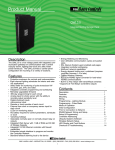
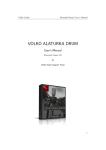
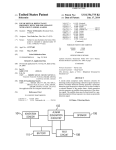
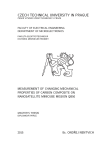
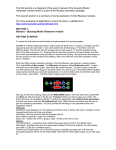


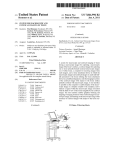
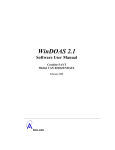

![[quote(var.text)]}](http://vs1.manualzilla.com/store/data/005937533_1-4dd3fe8a9b5a28fbfb6fbb268c8e3b66-150x150.png)


